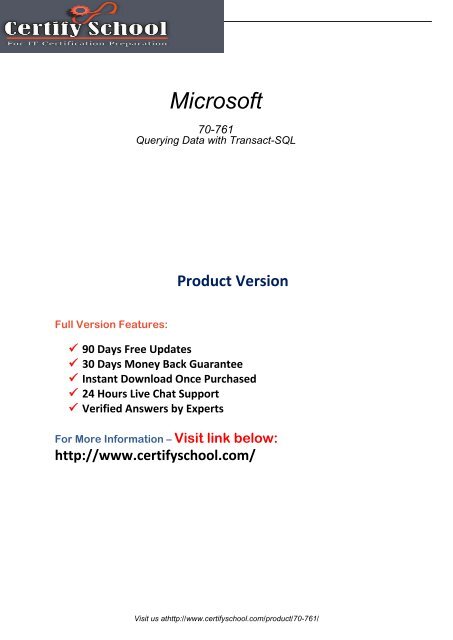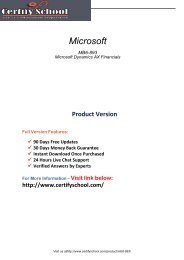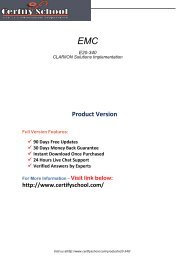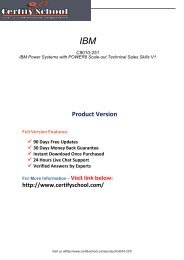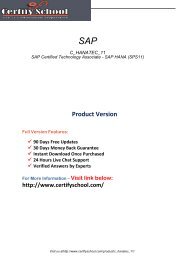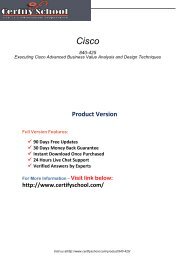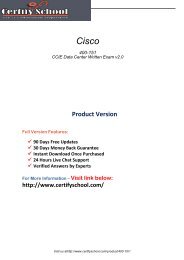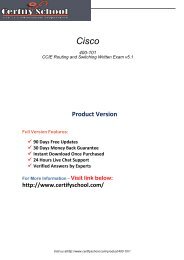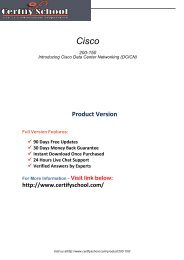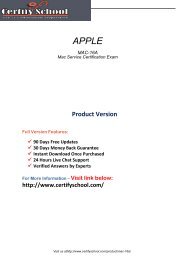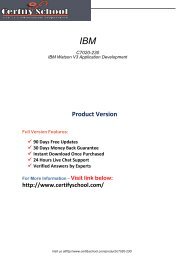70-761 Study Material
Provided study material for 70-761 Certification Test is created and checked by authorized persons of relevant industry. You can use this PDF training kits to pass your exam. For more info please visit here: http://www.certifyschool.com/product/70-761/
Provided study material for 70-761 Certification Test is created and checked by authorized persons of relevant industry. You can use this PDF training kits to pass your exam. For more info please visit here: http://www.certifyschool.com/product/70-761/
Create successful ePaper yourself
Turn your PDF publications into a flip-book with our unique Google optimized e-Paper software.
Microsoft<br />
<strong>70</strong>-<strong>761</strong><br />
Querying Data with Transact-SQL<br />
Product Version<br />
Full Version Features:<br />
90 Days Free Updates<br />
30 Days Money Back Guarantee<br />
Instant Download Once Purchased<br />
24 Hours Live Chat Support<br />
Verified Answers by Experts<br />
For More Information – Visit link below:<br />
http://www.certifyschool.com/<br />
Visit us athttp://www.certifyschool.com/product/<strong>70</strong>-<strong>761</strong>/
Question: 1<br />
Note: This question is part of a series of questions that present the same scenario. Each question in the<br />
series contains a unique solution that might meet the stated goals. Some question sets might have more<br />
than one correct solution, while others might not have a correct solution.<br />
After you answer a question in this section. you will NOT be able to return to it. As a result, these<br />
questions will not appear in the review screen.<br />
You create a table named Products by running the following Transact-SQL statement:<br />
You have the following stored procedure:<br />
You need to modify the stored procedure to meet the following new requirements:<br />
- Insert product records as a single unit of work.<br />
- Return error number 51000 when a product fails to insert into the database.<br />
- If a product record insert operation fails, the product information must not be permanently written to<br />
the database.<br />
Solution: You run the following Transact-SQL statement:<br />
Visit us athttp://www.certifyschool.com/product/<strong>70</strong>-<strong>761</strong>/
Does the solution meet the goal?<br />
A. Yes<br />
B. No<br />
Answer: B<br />
Explanation:<br />
With X_ABORT ON the INSERT INTO statement and the transaction will be rolled back when an error is<br />
raised, it would then not be possible to ROLLBACK it again in the IF XACT_STATE() 0 ROLLACK<br />
TRANSACTION statement.<br />
Note: A transaction is correctly defined for the INSERT INTO ..VALUES statement, and if there is an error<br />
in the transaction it will be caught ant he transaction will be rolled back, finally an error 51000 will be<br />
raised.<br />
Note: When SET XACT_ABORT is ON, if a Transact-SQL statement raises a run-time error, the entire<br />
transaction is terminated and rolled back.<br />
XACT_STATE is a scalar function that reports the user transaction state of a current running request.<br />
XACT_STATE indicates whether the request has an active user transaction, and whether the transaction<br />
is capable of being committed.<br />
The states of XACT_STATE are:<br />
0 There is no active user transaction for the current request.<br />
1 The current request has an active user transaction. The request can perform any actions, including<br />
writing data and committing the transaction.<br />
2 The current request has an active user transaction, but an error has occurred that has caused the<br />
transaction to be classified as an committable transaction.<br />
References:<br />
https://msdn.microsoft.com/en-us/library/ms188792.aspx<br />
https://msdn.microsoft.com/en-us/library/ms189797.aspx<br />
Question: 2<br />
Visit us athttp://www.certifyschool.com/product/<strong>70</strong>-<strong>761</strong>/
Note: This question is part of a series of questions that present the same scenario. Each question in the<br />
series contains a unique solution that might meet the stated goals. Some question sets might have more<br />
than one correct solution, while others might not have a correct solution.<br />
After you answer a question in this section. you will NOT be able to return to it. As a result, these<br />
questions will not appear in the review screen.<br />
You create a table named Products by running the following Transact-SQL statement:<br />
You have the following stored procedure:<br />
You need to modify the stored procedure to meet the following new requirements:<br />
- Insert product records as a single unit of work.<br />
- Return error number 51000 when a product fails to insert into the database.<br />
- If a product record insert operation fails, the product information must not be permanently written to<br />
the database.<br />
Solution: You run the following Transact-SQL statement:<br />
Visit us athttp://www.certifyschool.com/product/<strong>70</strong>-<strong>761</strong>/
Does the solution meet the goal?<br />
A. Yes<br />
B. No<br />
Answer: B<br />
Explanation:<br />
A transaction is correctly defined for the INSERT INTO ..VALUES statement, and if there is an error in the<br />
transaction it will be caught ant he transaction will be rolled back. However, error number 51000 will<br />
not be returned, as it is only used in an IF @ERROR = 51000 statement.<br />
Note: @@TRANCOUNT returns the number of BEGIN TRANSACTION statements that have occurred on<br />
the current connection.<br />
References: https://msdn.microsoft.com/en-us/library/ms187967.aspx<br />
Question: 3<br />
Note: This question is part of a series of questions that present the same scenario. Each question in the<br />
series contains a unique solution that might meet the stated goals. Some question sets might have more<br />
than one correct solution, while others might not have a correct solution.<br />
After you answer a question in this section. you will NOT be able to return to it. As a result, these<br />
questions will not appear in the review screen.<br />
You create a table named Products by running the following Transact-SQL statement:<br />
Visit us athttp://www.certifyschool.com/product/<strong>70</strong>-<strong>761</strong>/
You have the following stored procedure:<br />
You need to modify the stored procedure to meet the following new requirements:<br />
- Insert product records as a single unit of work.<br />
- Return error number 51000 when a product fails to insert into the database.<br />
- If a product record insert operation fails, the product information must not be permanently written to<br />
the database.<br />
Solution: You run the following Transact-SQL statement:<br />
Does the solution meet the goal?<br />
A. Yes<br />
B. No<br />
Answer: A<br />
Visit us athttp://www.certifyschool.com/product/<strong>70</strong>-<strong>761</strong>/
Explanation:<br />
If the INSERT INTO statement raises an error, the statement will be caught and an error 51000 will be<br />
thrown. In this case no records will have been inserted.<br />
Note:<br />
You can implement error handling for the INSERT statement by specifying the statement in a<br />
TRY…CATCH construct.<br />
If an INSERT statement violates a constraint or rule, or if it has a value incompatible with the data type<br />
of the column, the statement fails and an error message is returned.<br />
References: https://msdn.microsoft.com/en-us/library/ms174335.aspx<br />
Question: 4<br />
Note: This question is part of a series of questions that present the same scenario. Each question in the<br />
series contains a unique solution that might meet the stated goals. Some question sets might have more<br />
than one correct solution, while others might not have a correct solution.<br />
After you answer a question in this section. you will NOT be able to return to it. As a result, these<br />
questions will not appear in the review screen.<br />
You create a table named Customer by running the following Transact-SQL statement:<br />
You must insert the following data into the Customer table:<br />
You need to ensure that both records are inserted or neither record is inserted.<br />
Solution: You run the following Transact-SQL statement:<br />
Visit us athttp://www.certifyschool.com/product/<strong>70</strong>-<strong>761</strong>/
Does the solution meet the goal?<br />
A. Yes<br />
B. No<br />
Answer: B<br />
Explanation:<br />
As there are two separate INSERT INTO statements we cannot ensure that both or neither records is<br />
inserted.<br />
Question: 5<br />
Note: This question is part of a series of questions that present the same scenario. Each question in the<br />
series contains a unique solution that might meet the stated goals. Some question sets might have more<br />
than one correct solution, while others might not have a correct solution.<br />
After you answer a question in this section. you will NOT be able to return to it. As a result, these<br />
questions will not appear in the review screen.<br />
You create a table named Customer by running the following Transact-SQL statement:<br />
You must insert the following data into the Customer table:<br />
Visit us athttp://www.certifyschool.com/product/<strong>70</strong>-<strong>761</strong>/
You need to ensure that both records are inserted or neither record is inserted.<br />
Solution: You run the following Transact-SQL statement:<br />
Does the solution meet the goal?<br />
A. Yes<br />
B. No<br />
Answer: B<br />
Explanation:<br />
As there are two separate INSERT INTO statements we cannot ensure that both or neither records is<br />
inserted.<br />
Question: 6<br />
Note: This question is part of a series of questions that present the same scenario. Each question in the<br />
series contains a unique solution that might meet the stated goals. Some question sets might have more<br />
than one correct solution, while others might not have a correct solution.<br />
After you answer a question in this section. you will NOT be able to return to it. As a result, these<br />
questions will not appear in the review screen.<br />
You create a table named Customer by running the following Transact-SQL statement:<br />
You must insert the following data into the Customer table:<br />
Visit us athttp://www.certifyschool.com/product/<strong>70</strong>-<strong>761</strong>/
You need to ensure that both records are inserted or neither record is inserted.<br />
Solution: You run the following Transact-SQL statement:<br />
Does the solution meet the goal?<br />
A. Yes<br />
B. No<br />
Explanation:<br />
Answer: A<br />
With the INSERT INTO..VALUES statement we can insert both values with just one statement. This<br />
ensures that both records or neither is inserted.<br />
References: https://msdn.microsoft.com/en-us/library/ms174335.aspx<br />
Question: 7<br />
Note: This question is part of a series of questions that present the same scenario. Each question in the<br />
series contains a unique solution that might meet the stated goals. Some question sets might have more<br />
than one correct solution, while others might not have a correct solution.<br />
After you answer a question in this section. you will NOT be able to return to it. As a result, these<br />
questions will not appear in the review screen.<br />
You have a database that tracks orders and deliveries for customers in North America. The database<br />
contains the following tables:<br />
Sales.Customers<br />
Visit us athttp://www.certifyschool.com/product/<strong>70</strong>-<strong>761</strong>/
Application.Cities<br />
Sales.CustomerCategories<br />
The company’s development team is designing a customer directory application. The application must<br />
list customers by the area code of their phone number. The area code is defined as the first three<br />
characters of the phone number.<br />
The main page of the application will be based on an indexed view that contains the area and phone<br />
number for all customers.<br />
You need to return the area code from the PhoneNumber field.<br />
Solution: You run the following Transact-SQL statement:<br />
Visit us athttp://www.certifyschool.com/product/<strong>70</strong>-<strong>761</strong>/
Does the solution meet the goal?<br />
A. Yes<br />
B. No<br />
Answer: A<br />
Explanation:<br />
As the result of the function will be used in an indexed view we should use schemabinding.<br />
References: https://sqlstudies.com/2014/08/06/schemabinding-what-why/<br />
Question: 8<br />
Note: This question is part of a series of questions that present the same scenario. Each question in the<br />
series contains a unique solution that might meet the stated goals. Some question sets might have more<br />
than one correct solution, while others might not have a correct solution.<br />
After you answer a question in this section. you will NOT be able to return to it. As a result, these<br />
questions will not appear in the review screen.<br />
You have a database that tracks orders and deliveries for customers in North America. The database<br />
contains the following tables:<br />
Sales.Customers<br />
Visit us athttp://www.certifyschool.com/product/<strong>70</strong>-<strong>761</strong>/
Application.Cities<br />
Sales.CustomerCategories<br />
The company’s development team is designing a customer directory application. The application must<br />
list customers by the area code of their phone number. The area code is defined as the first three<br />
characters of the phone number.<br />
The main page of the application will be based on an indexed view that contains the area and phone<br />
number for all customers.<br />
You need to return the area code from the PhoneNumber field.<br />
Solution: You run the following Transact-SQL statement:<br />
Visit us athttp://www.certifyschool.com/product/<strong>70</strong>-<strong>761</strong>/
Does the solution meet the goal?<br />
A. Yes<br />
B. No<br />
Answer: B<br />
Explanation:<br />
As the result of the function will be used in an indexed view we should use schemabinding.<br />
References: https://sqlstudies.com/2014/08/06/schemabinding-what-why/<br />
Question: 9<br />
Note: This question is part of a series of questions that present the same scenario. Each question in the<br />
series contains a unique solution that might meet the stated goals. Some question sets might have more<br />
than one correct solution, while others might not have a correct solution.<br />
After you answer a question in this section. you will NOT be able to return to it. As a result, these<br />
questions will not appear in the review screen.<br />
You have a database that tracks orders and deliveries for customers in North America. The database<br />
contains the following tables:<br />
Sales.Customers<br />
Application.Cities<br />
Sales.CustomerCategories<br />
Visit us athttp://www.certifyschool.com/product/<strong>70</strong>-<strong>761</strong>/
The company’s development team is designing a customer directory application. The application must<br />
list customers by the area code of their phone number. The area code is defined as the first three<br />
characters of the phone number.<br />
The main page of the application will be based on an indexed view that contains the area and phone<br />
number for all customers.<br />
You need to return the area code from the PhoneNumber field.<br />
Solution: You run the following Transact-SQL statement:<br />
Does the solution meet the goal?<br />
A. Yes<br />
B. No<br />
Explanation:<br />
The variable max, in the line DECLARE @areaCode nvarchar(max), is not defined.<br />
Question: 10<br />
Answer: B<br />
Note: This question is part of a series of questions that use the same scenario. For your convenience, the<br />
scenario is repeated in each question. Each question presents a different goal and answer choices, but<br />
the text of the scenario is exactly the same in each question in this series.<br />
You query a database that includes two tables: Project and Task. The Project table includes the following<br />
columns:<br />
Visit us athttp://www.certifyschool.com/product/<strong>70</strong>-<strong>761</strong>/
You plan to run the following query to update tasks that are not yet started:<br />
You need to return the total count of tasks that are impacted by this UPDATE operation, but are not<br />
associated with a project.<br />
What set of Transact-SQL statements should you run?<br />
A. Option A<br />
B. Option B<br />
C. Option C<br />
D. Option D<br />
Visit us athttp://www.certifyschool.com/product/<strong>70</strong>-<strong>761</strong>/
Answer: B<br />
Explanation:<br />
The WHERE clause of the third line should be WHERE ProjectID IS NULL, as we want to count the tasks<br />
that are not associated with a project.<br />
Visit us athttp://www.certifyschool.com/product/<strong>70</strong>-<strong>761</strong>/
Powered by TCPDF (www.tcpdf.org)<br />
For More Information – Visit link below:<br />
http://www.certifyschool.com/<br />
Thanks for Using Our Product<br />
Visit us athttp://www.certifyschool.com/product/<strong>70</strong>-<strong>761</strong>/


